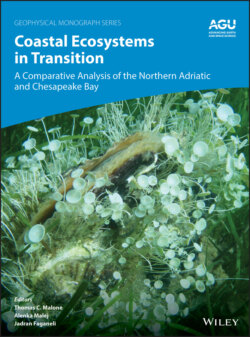Читать книгу Coastal Ecosystems in Transition - Группа авторов - Страница 28
2.2. OVERVIEW OF THE WATERSHED AND FRESHWATER INPUTS
ОглавлениеChesapeake Bay is a large estuary in the Mid‐Atlantic region of the United States. Among its many tributaries, nine account for over 90% of river flow into CB (Chanat et al., 2016; Moyer et al., 2012). The watershed of the Susquehanna River, the largest river discharging directly into the mainstem bay, comprises about 43% of total CB watershed and is dominated by forested areas (~65%). The NAS is a shallow, semienclosed arm of the NE Mediterranean Sea. The Po River, the largest river discharging into the NAS, has a watershed that comprises 67% of the total NAS watershed and hosts large urban and industrial settlements, as well as extended areas of intensive cropping and livestock activities (Seagle et al., 1999).
River flows into CB, and associated inputs of nutrients and sediments, are monitored by the US Geological Survey (US Geological Survey, 2018). For the NAS, flow rates of Italian rivers are monitored the Hydrographic and Mareographic National Service of Italy (1917–1990s) and the Regional Environmental Protection Agencies (1990s to today). Nutrient data were obtained from the scientific literature, monitoring programs, and past projects (Cozzi & Giani, 2011; Cozzi et al., 2019). Data for the Istrian Rivers were provided by the Environmental Agency of the Republic of Slovenia, the Croatian Meteorological and Hydrological Service, and the European Environmental Agency.
The volume transports (Q) of major rivers flowing into CB and the NAS are similar and exhibited strong interannual variability during 1985–2015 (Figure 2.1). On average, the Susquehanna accounts for 62% of riverine inputs of freshwater while the Po accounts for 69%. The highest transports in CB watershed occurred during the years 1996, 2004, and 2011 in association with major hurricanes and tropical storms (Figure 2.1a). River flows to the NAS were characterized by a maximum during 2014 and lows during the drought period of 2003–2007 (Figure 2.1b).
Figure 2.1 Time series of annual freshwater input to (a) Chesapeake Bay and (b) northern Adriatic Sea and boxplots of seasonal freshwater input to (c) Chesapeake Bay and (d) northern Adriatic Sea in the period of 1985–2015, including input from the largest river (Susquehanna and Po, respectively), input from all major tributaries, and direct wet precipitation.
The volume transports of major rivers flowing into CB and the NAS show strong seasonal variability. Seasonal peaks tended to occur during January–March and April–June in CB rivers (Figure 2.1c). In comparison, seasonal peaks tended to occur during April–June and October–December in the NAS (Figure 2.1d). Direct precipitation to the sea surface was estimated to account for 14–29% of seasonal freshwater input to CB and for 10–23% of the input to the NAS. For both systems, direct precipitation is more important in July–September relative to other months that have higher Q.
Freshwater inputs to CB and the NAS were further compared on a centennial scale using data from the Susquehanna and Po Rivers. During 1900–2015, the Susquehanna annual Q has an estimated Mann–Kendall (MK) trend slope of ‐0.0063 km3 year−1 (p = 0.79). On a seasonal basis, Susquehanna Q had negative slopes in all four seasons, i.e., ‐0.010, ‐0.038, ‐0.095, and ‐0.025 km3 year−1 in January–March, April–June, July–September, and October–December, respectively, with the latter three trends being statistically significant. During 1917–2015, the Po annual Q has an estimated trend slope of 0.016 km3 year−1 (p = 0.86). On a seasonal basis, Po Q was estimated to have positive slopes in January–March (0.0050 km3 year−1) and October–December (0.0006 km3 year−1) and negative slopes in April–June (‐0.012 km3 year−1) and July–September (‐0.015 km3 year−1), with the July–September trend being statistically significant.
